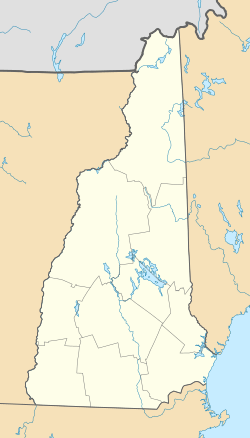Chocorua Island Chapel facts for kids
Quick facts for kids |
|
|
Chocorua Island Chapel
|
|
| Nearest city | Holderness, New Hampshire |
|---|---|
| Built | 1881 |
| Website | Chocorua Island Chapel Association |
| NRHP reference No. | 16000644 |
| Added to NRHP | September 20, 2016 |
The Chocorua Island Chapel is a special outdoor chapel located on an island in Squam Lake in Holderness, New Hampshire. It's a place where people of any faith can come to worship. This unique chapel was created by young boys who were part of the first-ever summer camp in the United States. They built it using natural materials like boulders, trees, plants, and beach sand from the island.
Contents
The First Summer Camp
How the Camp Started
Ernest Berkeley Balch was born in 1860. He was one of fourteen children. His father was an Episcopal minister. Ernest was inspired to start a wilderness camp for young boys after camping with friends on Squam Lake. He wanted the camp to help boys become stronger physically and also grow spiritually.
Building the Camp
With help from his college friends, Ernest built the camp on Chocorua Island. The camp opened in the summer of 1881. It was later discovered that the island was not public land, but an agreement was made with the owner so the camp could continue. Even though the camp didn't make money for its investors, it is known as the very first summer youth camp in America. It helped start the idea of summer camps for kids all over the country.
The Chapel's Story
How the Boys Built It
The open-air chapel was built by the boys during the camp's first summer. They cleared the land and used only natural things they found. From Squam Lake, they found a large piece of granite that was shaped perfectly for a lectern (a stand for reading). They placed it next to a big granite boulder that they used as an altar. On Sundays, both the altar and lectern were decorated with ferns and wildflowers. The benches and the cross were made from trees found on the island. Beach sand was used for the floor. Two services were held every Sunday: one in the afternoon for visitors and one in the evening for the boys before bedtime.
The Chapel After the Camp
The summer camp itself stopped operating after the 1889 season. However, the chapel continued to be used by visitors to the island. In 1903, a group of eight people formed the Chocorua Chapel Association. This association took over the responsibility of running and maintaining the chapel. They also started giving donations received by the chapel to non-profit groups in the community.
A famous visitor to the chapel was Grover Cleveland, who was a former President of the United States. He attended worship services there in the summer of 1904. Even though the camp buildings were falling apart by then, the chapel continued to offer services for visitors and people living nearby. Over time, the Association decided to run the chapel as a non-denominational place, meaning it was open to people of all faiths. In 1928, the owner of the island gave it to the Association.
National Recognition
What is NRHP Certification?
The Chocorua Island Chapel was added to the National Register of Historic Places on September 20, 2016. Being on this list means that the chapel is recognized as an important historical place in the United States.
Important Parts of the Chapel
Many parts of the chapel and the island helped it qualify for this special recognition. At the south end of the island, where people arrive, important features include the wharf (a dock), the sea wall, other docks, two crosses, and a shelter for a memory book. At the north end, where the chapel is located, many parts are considered historically important. These include the cross and altar, the lectern, a baptismal font, the benches, the bell and its tower, the organ, a small hut for robes, and a stone wall.



